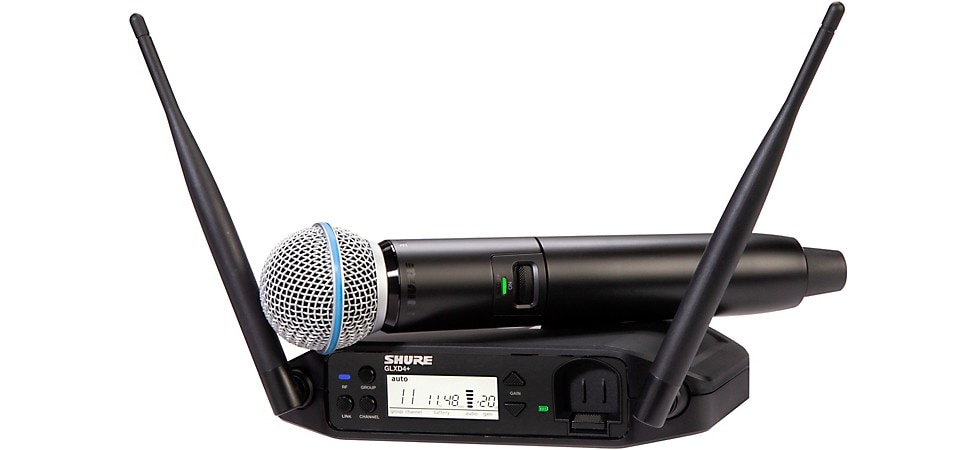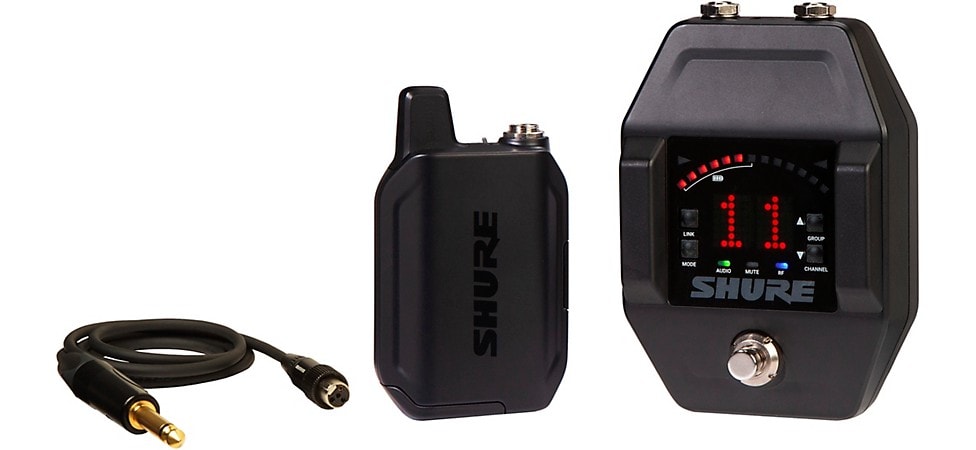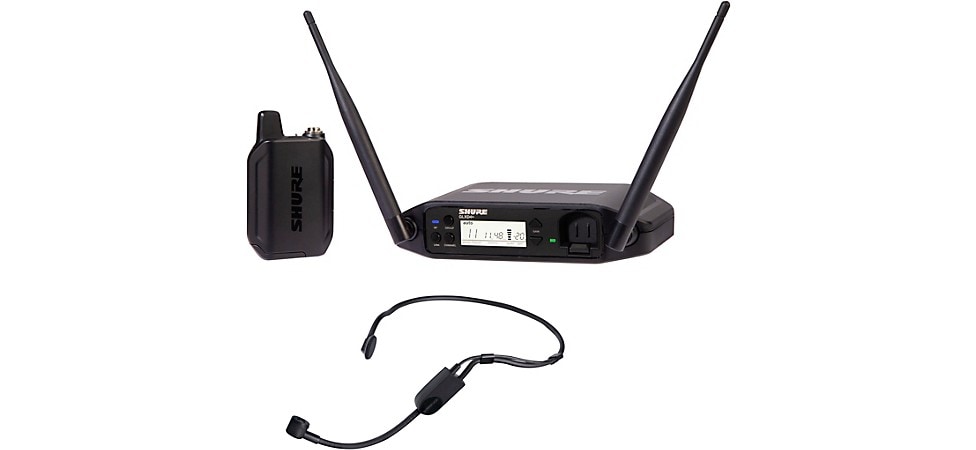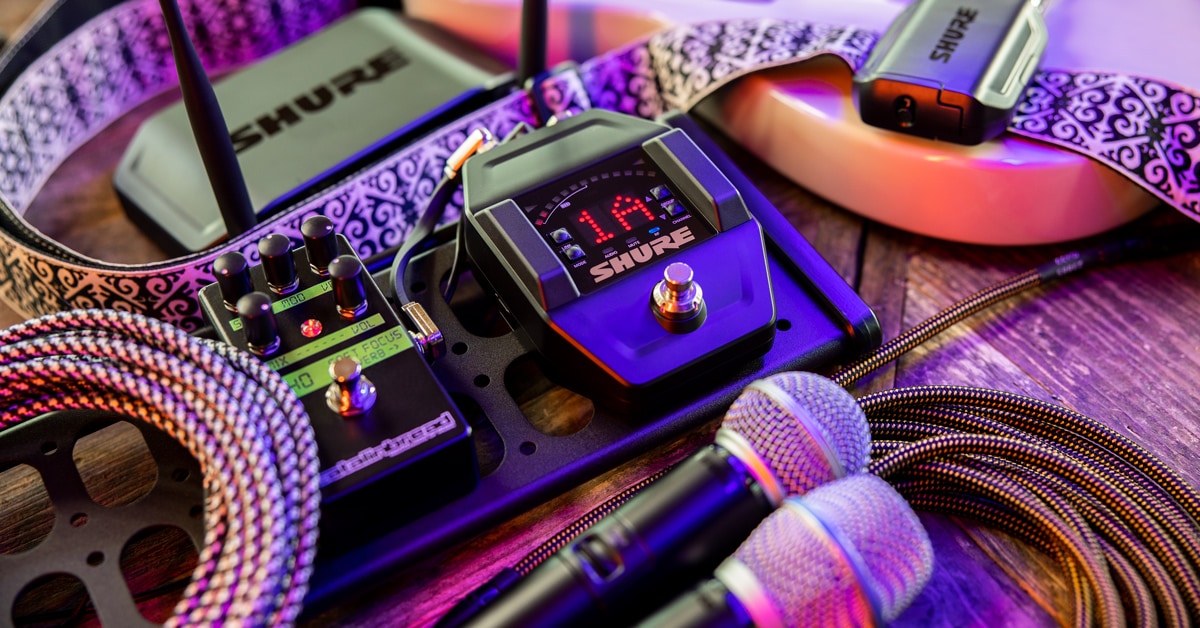The new Shure GLX-D+ Dual Band Wireless System provides vocalists and guitarists with a reliable and automated way to cut the cord. Almost like having an AI-driven watchdog for your sound, the GLX-D+ Dual Band instantly links up the transmitter and receiver, and then constantly monitors wireless frequencies to guard against interference, dropouts and other audio glitches.
The GLX-D+ Dual Band family includes a vocal system that lets you choose your microphone from a trio of renowned Shure vocal capsules (SM58, BETA 58A and BETA 87A), lavalier and headset mic options and a pedal-based unit for guitarists and bassists that includes an onboard tuner. The “Dual Band” in the name refers to the system’s 2.4GHz and 5.8GHz spectrums that double the available bandwidth for wireless transmission, as well as stay clear of often-crowded UHF television frequencies.
To enlighten musicians about the new GLX-D+ Dual Band system, we have Shure’s Associate Director of Product Management Mike Nagel. Nagel is a 25-year veteran of the company who has amassed considerable working and development experience with Shure wireless systems, including ULX-D, PSM 900, BLX, GLX-D and right up to the new GLX-D+ Dual Band.
“In product management, we plan the roadmap of new product lines, collaborate with development teams, devise market messaging and sales operations and, most importantly, talk to our customers around the world,” says Nagel. “What we try to do is make things simple for the average person, as well as provide tools that can save time for these professionals.”
Here are some insights into how Nagel and his team developed the Shure GLX-D+ Dual Band system to provide worry-free wireless for vocalists, guitarists, bassists and speakers.
What were some of the user “pain points” you wanted to alleviate with the GLX-D+ Dual Band project?
Mike Nagel: Typically, when people want to go wireless, the desire comes from a wish to have the freedom to move wherever they want on stage. But when they start looking into wireless systems, it can be overwhelming. There are technical details, specs, frequencies, battery management, operating the gear while performing and, sometimes, concerns that wireless will impact their sound. Honestly, there can be a bit of fear about going wireless. We took all of these concerns and continually designed and tested solutions until we knew we had it right. Our goal with GLX-D+ Dual Band is to deliver a system that takes care of itself, so you can focus on expressing yourself.
What are the benefits of dual-band technology in the GLX-D+ system?
GLX-D+ Dual Band has a few layers that deliver the reliability you need—especially as the wireless spectrum isn’t a topic performers want to think about until there’s a challenge. As it’s possible that one band may be more occupied than another in a given environment, we wanted to provide as many options as possible in a simple system. Out of the box, GLX-D+ Dual Band automatically links your transmitter and receiver, and you’re ready to go. Then, behind the scenes, the system continues to scan the environment to see where it might need to adapt by automatically and seamlessly moving away from interference. Should you add more systems—or travel to new locations—you can always press the channel button to reevaluate the environment and determine if it’s best to operate in 2.4GHz or 5.8GHz.

Pictured: Shure GLX-D24+ Vocal System with BETA 58A Microphone
These new units operate for up to 12 hours and can be recharged via USB-C. How does that compare to the prior generation?
The most recent offering of the previous generation ran approximately 11 hours. Also, going wireless often comes with the additional cost of replacing alkaline batteries, and when people did the math, they realized they spent more replacing batteries than they did on the wireless system itself. The GLXD4+ and GLXD4R+ feature smart rechargeability, so the included lithium-ion SB904 battery can be charged using USB-C via a convenient, built-in charging bay. This reduces the cost of ownership and waste by replacing approximately 2,000 alkaline batteries. There’s also the option for a quick 15-minute charge that provides 1.5 hours of runtime.
For guitarists or bassists who haven’t considered a wireless system before, what will the GLXD6+ offer them that they won’t find in other systems?
The development team consisted of multiple guitarists who were passionate about delivering the most rugged pedal available, along with an exceptional, built-in tuner. Most days, I’d see the development team working on the tuner so it could live up to the needs of players, such as having the option for strobe or needle-style tunning. Additional features include adjustable pitch reference from 432Hz to 447Hz, selectable sharp/flat indication, live or muted tuning, automatic display brightness and an optional 1/4" input for situations where you don’t need wireless, such as rehearsals.

Pictured: Shure GLX-D16+ Guitar Pedal System
GLX-D+ Dual Band operates in the FCC’s license-free frequency ranges of 2.4GHz and 5.8GHz, rather than the UHF television spectrum. What does this mean for those who rely on GLX-D+ in touring situations?
The practical benefit with GLX-D+ Dual Band is that it operates outside of the UHF bands, as you just mentioned. As a result, with a GLX-D+ system, you can usually plug in, play and forget about it. Of course, there also are many benefits to traditional UHF wireless systems, and we often recommend them for large venues. However, touring acts that go from city to city might find a location that’s more challenging than others, depending on the local UHF frequencies being used. There are ways to work around over-the-air TV in UHF wireless systems, but some solutions may be more limited than others, or you may not want to negotiate the various wireless bands by yourself.
GLXD2+ Dual Band provides the option to select one vocal-mic capsule from an assortment of three different types. How can a singer determine which microphone capsule is the best one for them?
The handheld mic options include our SM58, BETA 58A and BETA 87A. I usually recommend the BETA 87A for someone who wants to bring out the subtleties and details of their performance, as it allows more high frequencies to get through. However, the BETA 87A is less well suited to a hard-driving vocal sound. The SM58 and BETA 58A share similarities in that they’re both dynamic mics with very broad uses that easily accommodate heavier vocal styles. You can’t go wrong with the SM58, as it has been a top vocal mic for decades, and it cuts through practically any mix. The BETA 58A has a few advances that some vocalists appreciate, such as a tighter pickup pattern, a hotter output, an extended frequency response and less handling noise.

Pictured: Shure GLX-D14+ Headset System with PGA31 Headset Microphone
How scalable is the system?
Most bands could be covered with each vocalist using individual systems. Typically, up to five different channels can be accommodated. However, there are significant benefits that come from a complete solution set that includes GLXD4R+ receivers, GLXD+FMZ3 Dual Band Frequency Manager and PA805DB-RSMA directional antennas. The Frequency Manager acts as the brains for the entire system to deliver improved performance, increased channel count and spectral efficiencies via intelligent frequency sharing. I usually recommend considering this setup for four or more systems.
Can you share any tips to ensure musicians get the best wireless system experience with their GLX-D+?
The most important things to keep in mind for all wireless systems is to minimize the distance from the performer to the receiving antenna, and to maintain line-of-sight from transmitter to receiver. In addition, GLX-D+ Dual Band is best suited to having the receivers or directional antennas onstage or nearby, as opposed to far out into the audience. If you need to cover a large venue, Shure has plenty of other options, as our products have been used at the Super Bowl, the Olympics and on massive arena tours. Another tip is to locate antennas or receivers 10 feet away from other 2.4GHz and 5.8GHz sources. For the most part, however, the GLX-D+ Dual Band wireless system adjusts to the environment as needed, so you can focus on the show.










